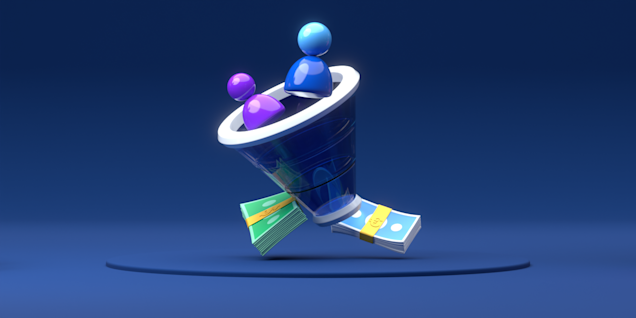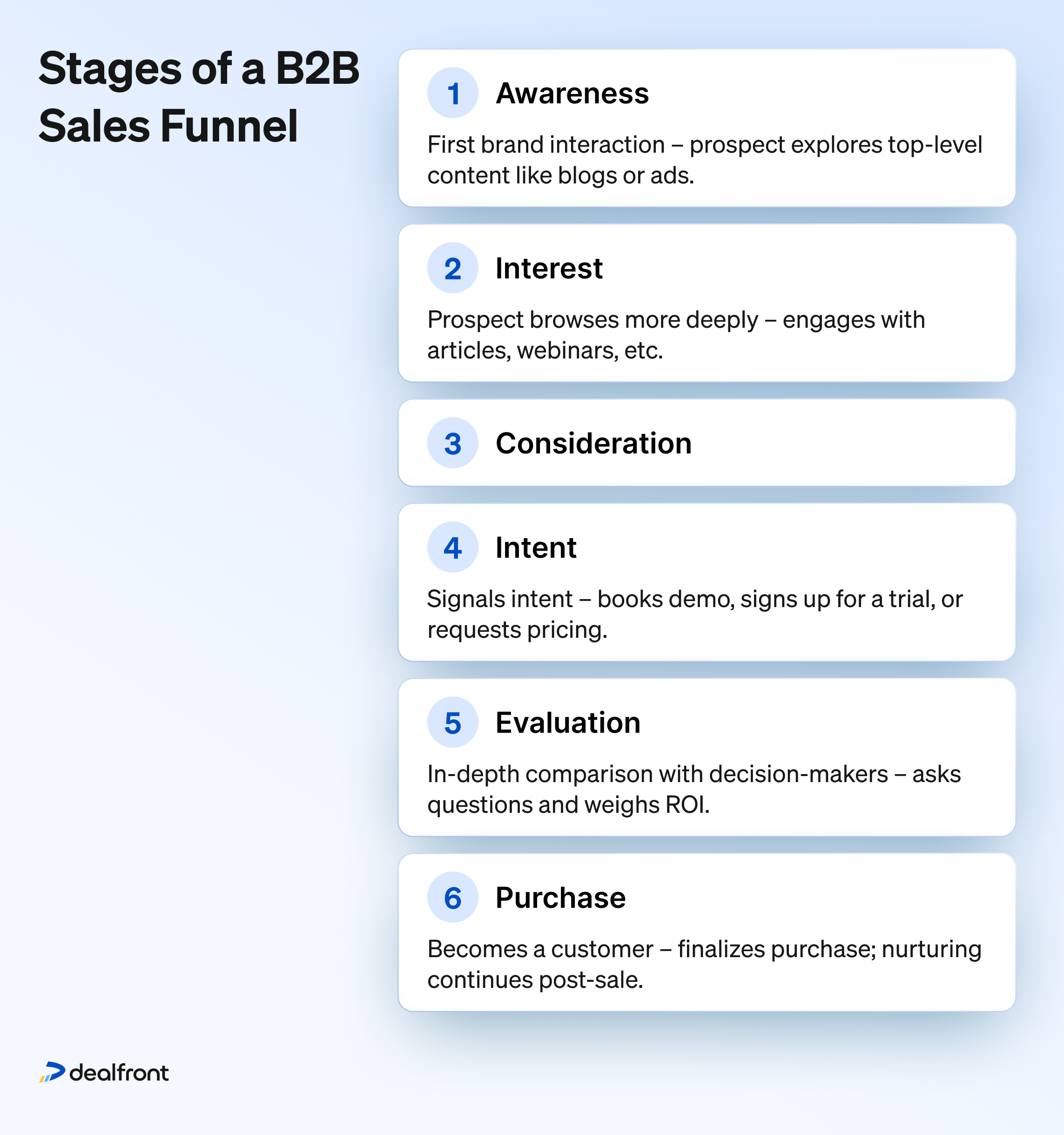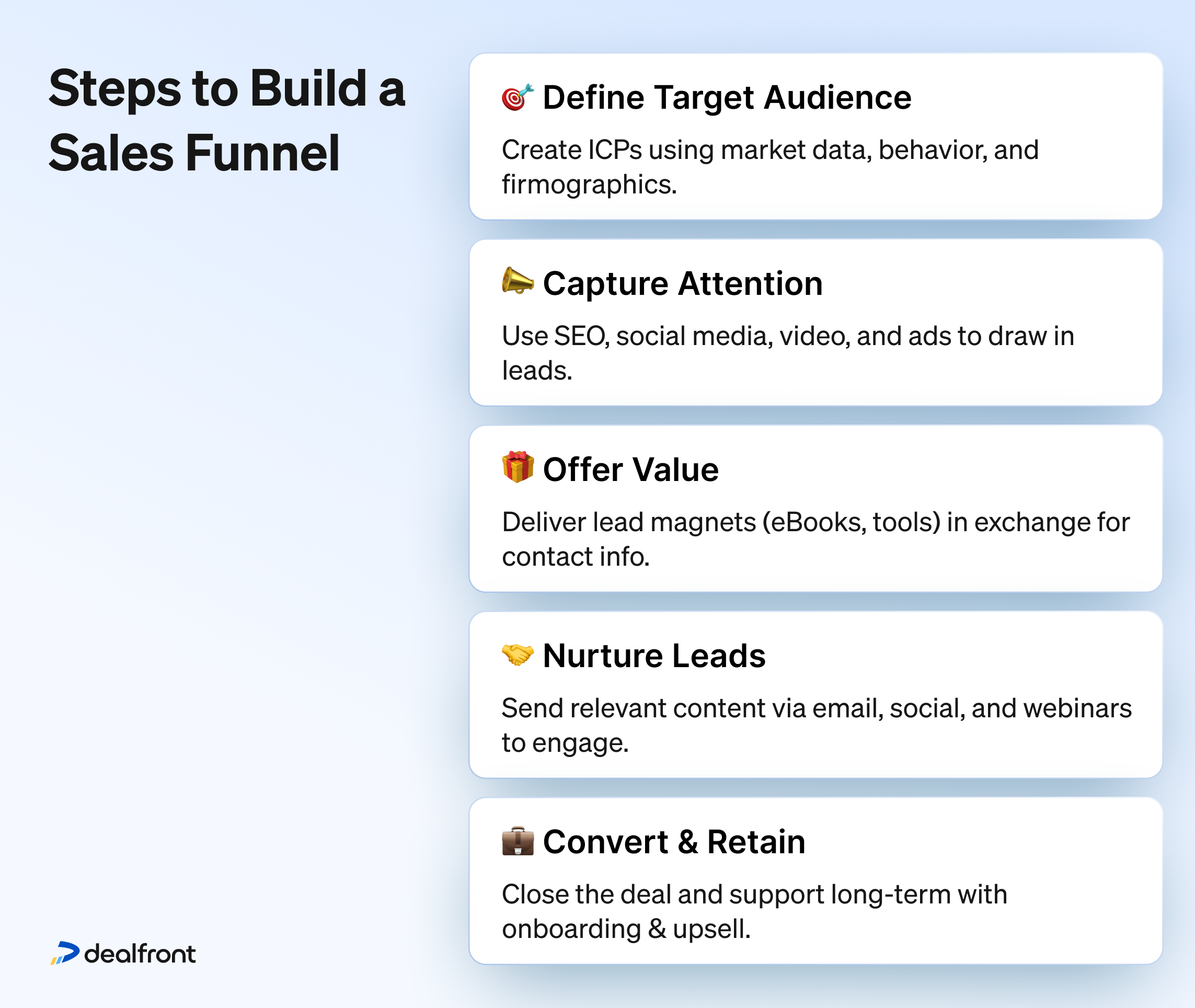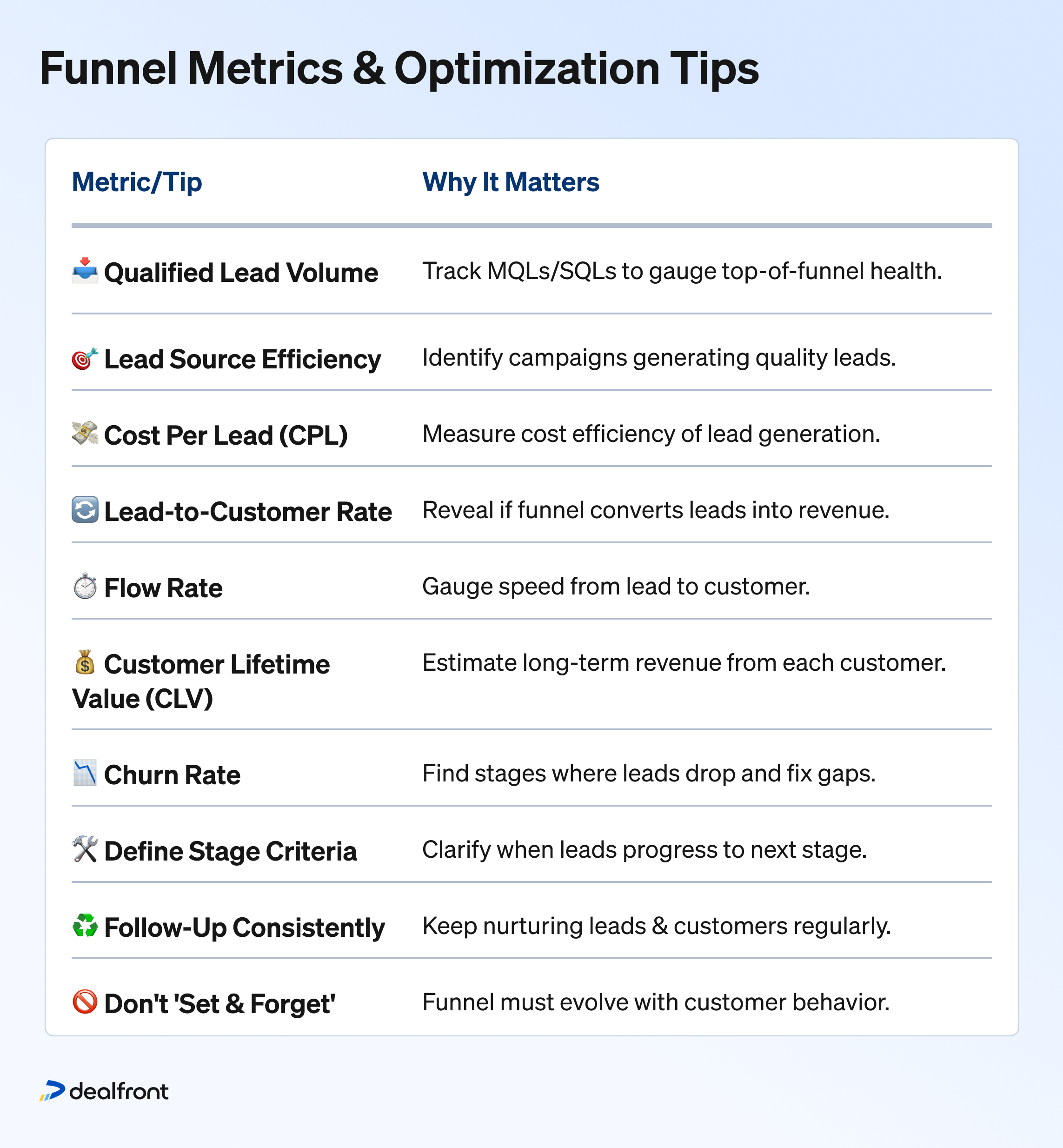An ineffective, gap-riddled sales funnel is a serious problem for your business.
AlleVertrieb
What Is a Sales Funnel? Learn the Stages & How to Build and Optimize Yours

It leaves you with low-quality leads at the top of the funnel—leads that fall out of your buying journey like water through a sieve, until you’re left with just a trickle at the bottom.
An optimized sales funnel pulls in high-quality leads and seamlessly steers them along your buying journey. Instead of a trickle, you have a steady stream of paying customers.
But what exactly is a sales funnel? In this guide, we’ll explore the types of sales funnels, the different stages, and how you can optimize yours using strategies, best practices, and sales funnel tools.
What is a sales funnel?
Sales funnels are a bit of an elusive concept. They’re related to, but not the same as, marketing funnels and sales pipelines. So, let’s get sales funnels explained. We’ll explore what they are, how they differ from other sales and marketing models, and two different types of sales funnels.
Sales funnel definition
A sales funnel is a visual model that illustrates your prospective customers' journey as they progress from a sales lead to a paying customer.
The top of the funnel (awareness) is where you’ll have the largest pool of potential customers. As prospects travel down to the middle of the funnel (interest, consideration, and intent), the pool of potential buyers grows smaller until you’re left with a smaller number of leads at the bottom of the funnel (evaluation and purchase).
Ultimately, we can define sales funnel models as visual roadmaps that show you where sales leads are in the buying cycle. This gives you insight into the types of content and interactions you should be delivering.
Sales funnel vs marketing funnel
Sales funnels and marketing funnels are so closely aligned that they overlap, but they aren’t quite the same.
While a marketing funnel also visually represents the customer journey, it typically ends at the point where a lead is ready to be passed from marketing to sales. It focuses more on converting wide audiences from “unaware” to “aware” using techniques like content marketing, advertising, and PR.
Once aware of your brand, customers are nurtured down the funnel with content that builds brand trust, credibility, and relationships. Unlike a sales funnel, where the end goal is always to close a deal, a marketing funnel aims to convert marketing-qualified leads (MQLs) into sales-qualified leads (SQLs).
Sales funnel vs sales pipeline
Sales funnels and sales pipelines represent two sides of the same coin. A sales funnel maps your customers’ path to conversion, while a sales pipeline maps the specific sales activities your team must undertake to guide prospects down this path.
A sales pipeline will use your sales funnel as a guide to identify the tasks that must be completed at each stage to progress leads and ultimately close deals. It encompasses various internal sales activities like prospect qualification, meetings, proposals, and deal closing.
B2C vs B2B sales funnel
B2C and B2B customers have different buying journeys, which is reflected in their distinct sales funnels.
The B2C sales process predominantly targets individual customers who make smaller-volume purchases. Purchasing motivations are highly personal and sometimes spontaneous, which makes the B2C sales funnel shorter and more linear. It generally consists of just four key stages: awareness, interest, desire, and purchase.
A B2B sales funnel is much more complex, containing six or more stages. This is because B2B buying cycles involve multiple decision-makers who make higher-value purchases. Depending on the product, they also need to consider complex factors like company budgets, integrations, security, and potential risks.
These two types of sales funnels vary significantly in length and strategy. A B2C customer might travel through the entire sales funnel in a day after only consuming a couple of pieces of content. A B2B customer could take months to convert, requiring long-term nurturing and engagement.
Why is a sales funnel important?
Building a strategic sales funnel for your business does more than structure your customer journey. It unlocks key insights that help you optimize strategies, prevent leakage, and increase conversions. In short, it:
Streamlines the customer journey: The transition from awareness to purchase should be as smooth as possible. By knowing exactly where leads are in their decision-making process, you can target them with messages that serve their immediate needs to aid natural, streamlined funnel progression.
Prevents sales funnel leakage: If inefficiencies and gaps exist in the customer journey, prospects will drop off or “leak” out of your sales funnel before they’ve converted. An optimized sales funnel plugs these gaps. It ensures that every stage in the customer journey is supported by the right sales activities.
Focuses sales efforts on the right prospects: Sales funnels help you identify which leads are ready to convert and which leads still need more time. This means you can target the right customer with the most relevant sales activities to keep them in the funnel—and cinch conversions at the exact moment they express purchasing intent.
Drives targeted improvements: Splicing your customer journey into different funnel stages makes strategies easier to track. You can evaluate each step individually to identify areas that need optimizing.
Ultimately, sales funnels increase conversion rates and sales by helping you create a streamlined customer journey that’s optimized for conversion.
Sales funnel stages
B2B sales funnels have six distinct stages: Awareness, interest, consideration, intent, evaluation, and purchase.
Understanding these stages will help you create a sales funnel template that works for you.

1. Awareness
Customers who enter the awareness stage are engaging with your brand for the first time. They might be seeking a solution to a specific pain point and have stumbled across your brand via a blog post, social media ad, cold email campaign, or word-of-mouth.
The awareness stage has the largest number of prospects, but they’re not necessarily looking to make a purchase. It’s similar to when a customer walks past a brick-and-mortar store and stops to take a look at your window display—they’re simply intrigued.
2. Interest
Prospects that move from the awareness stage to the interest stage are delving deeper into your content. They may know what type of product they need and are exploring your offerings to get a better idea of what features and services you can provide.
In other words, they’ve officially stepped inside your shop and are now browsing through the items on the rack.
Of all the stages in sales funnel models, the interest stage is where many customers drop off. It’s crucial to retain interest through educational, engaging, thought-leadership content like webinars, articles, and in-depth guides.
3. Consideration
At the consideration stage, a potential buyer might have a shortlist of products and is considering which one best fits their needs. They’ll use resources like case studies, whitepapers, testimonials, and customer reviews to analyze your product and services.
Here is where your content needs to hone in on the unique benefits that your product provides to set yourself apart from competitors.
4. Intent
The intent stage marks the point where a prospect expresses an intent to buy. In a B2B sales funnel, a prospect will demonstrate clear purchasing intent by signing up for your free trial or demo, booking a meeting with your sales team, or requesting a pricing proposal.
Identifying and acting on intent to buy is crucial for sales teams, who must quickly respond to these leads with personalized sales messages.
5. Evaluation
Prospects in the evaluation stage are considering every factor influencing their decision to purchase. They pull in other key B2B decision-makers to perform an in-depth cost-benefit analysis, aiming to align your solution with their specific business needs.
Here, prospects may reach out to your sales team with specific questions, so timely responses are key. It’s also where you might reach out with a customized offer or discount to incentivize the customer to move to the final stage—purchase.
6. Purchase/conversion
The very bottom of the sales funnel is where the prospect decides to become a paying customer. They’ll either purchase your product or negotiate with you to settle on a price.
But it’s not the end of the customer journey—existing customers are still targeted with sales and marketing content that’s designed to increase loyalty, advocacy, and retention.
With the six sales funnel stages explained, let’s move on to some examples.
Sales funnel examples
As we mentioned earlier, B2C and B2B sales funnels have different stages, lengths, and activities. Let’s walk through hypothetical examples of sales funnel models for both types of business to see how they might look in action.
B2C sales funnel example
Imagine you’re an ecommerce sports retailer that sells athletic footwear. You start a social media campaign on Instagram that advertises your sports shoes to gym enthusiasts.
Awareness: Your social media ads are shown to your target audience. They click on the ad, which directs them to a landing page that showcases your best-selling shoes.
Interest: The customer’s interest is piqued. They start to browse your website, taking a look at your product selection and maybe checking reviews before leaving your website.
Desire: To incentivize customers back into the funnel, you retarget them with more social media ads. But this time, you direct them to a landing page that offers a 20% discount, or you recommend complementary products, like insoles or matching gym gear. This stirs up desire, prompting the customer to take action.
Action: The customer adds the product to their online cart and checks out. Just like that, you’ve made a sale.
B2B sales funnel example
Let’s say you’re a SaaS company selling business communications software. You’ve created search engine optimized blog articles to drive customers to your website.
Here’s what your sales funnel might look like in action:
Awareness: A prospect is searching for ways to improve their customer service interactions. Google’s search engine results page (SERP) shows them your blog post; “10 Ways to Deliver Exceptional Customer Service.” By clicking through to your website and reading the article, they officially enter the sales funnel.
Interest: Within your article, there are several internal links that expand on the subject. The prospect clicks on these links to dive deeper. They’re then shown a pop-up asking them to subscribe to your email list for a free ebook or to join your webinar on a related topic. By converting, the customer moves down the funnel.
Consideration: Now that they’re fully familiar with your brand, the customer starts to view your product pages, pricing pages, testimonials, and case studies. They’re also receiving emails that nurture their interest by directing them to relevant content.
Intent: The prospect has consumed the above content and is displaying buying intent. They’re contacted by your sales team, who let them know about your free trial or demo.
Evaluation: Your sales team reaches out again, offering to answer any questions or perform a sales demonstration. They also reiterate the value of your product and how it will benefit the individual needs of the prospect.
Purchase: The customer decides to purchase, and you close the deal.
Of course, sales funnels are rarely so linear. Prospects might go back and forth between stages, interacting with various types of content across different channels that may or may not accurately reflect their true interest or intent.
So, it helps to use sales funnel tools to automate the process of lead generation, qualification, and engagement—more on that later.
How a sales funnel works from a customer perspective
For most customers, sales funnels have no real relevance to their journey.
When a customer is browsing your online products, they don’t align it with being in the interest stage—they’re simply browsing. When they sign up for your email list, they won’t note that they’ve transitioned down the sales funnel. As far as they’re concerned, they’re just going through the natural online shopping process.
This may not be the case for B2B buyers, as they use sales funnels to convert their own customers. But even so, any recognition of what stage in the funnel they’re in has no real impact. All a customer really cares about—B2C and B2B alike—is that your content and messages are relevant to their needs.
Developing a sales funnel strategy: How to build a sales funnel
Building a sales funnel is straightforward on paper. But in reality, it takes careful strategizing and analysis to ensure that prospects don’t fall off.
Let’s explore how you can build a sales funnel that targets, nurtures, and converts potential customers:

1. Identify and define a target audience
Each stage of your sales funnel should be tailored to meet the unique needs of your target audience, so you can effectively guide them toward conversion. But exactly who is your target audience?
Using market research, analytics, historical sales data, and competitive analysis, aim to create ideal customer profiles (ICPs) that clearly define the types of companies that need your product.
Collect data like:
Company size
Industry
Budget
Geography
Buying process
Decision-makers
Pain points
Business goals and needs
Social media platform preferences
Content preferences
2. Create something to capture their attention
To pull your target audience into your sales funnel, create attention-grabbing campaigns and content that compel them to check out your brand.
Some of the best top-of-the-funnel content includes blog posts, social media content, videos, and paid ads:
Blog posts and articles: What questions and subjects are your target audience searching for online? Write content that covers these topics, using SEO strategies to match search intent and increase SERP rankings. The top three Google results receive 54% of all clicks, so aim high.
Social media content: Develop a social media presence on the platforms your target audience uses, such as LinkedIn or Facebook. Share posts, images, and videos that reel audiences in and encourage them to follow your page, engage with your content, and click through to your website.
Videos: Educate, engage, and convert audiences with video content. Original series videos have the highest conversion rate at 30% according to a recent Wistia study. Webinars, sales videos, and customer testimonials are also high performers.
Paid ads: Target potential customers with paid ads that showcase your products. Search engine, social media, and display ads can put your brand in front of millions of new eyes, grabbing their attention and encouraging clicks.
3. Offer them value
Once you’ve captured your prospects’ attention, lure them further down the sales funnel by offering them something of value. The best way to do this is by creating a compelling lead magnet.
A lead magnet is a free asset that you offer to customers in exchange for their contact information (email addresses, phone numbers, etc.). It has to be something that’s relevant and valuable to your audience, such as an ebook, template, whitepaper, or another form of downloadable content.
It could even be a free tool or service—they’re the most effective lead magnets of them all.
Create a compelling landing page for your lead magnet that communicates the benefits of your offer, complete with a simple lead form and a strong call-to-action (CTA).
4. Nurture your lead
Once you’ve obtained your lead’s email address, you can nurture them down the funnel toward conversion.
Use the data you’ve gathered about your lead to suggest relevant content that you think they’d be interested in. Create different types of content, such as videos, articles, case studies, and testimonials, and link to them in your emails. You can do the same over on the social media platforms that your leads follow you on.
Along with providing useful information, boost engagement by hosting and participating in webinars and events. Send leads exclusive invitations and keep them updated with drip campaigns.
5. Convert and build a relationship
Your ultimate goal is to lead prospects to the bottom of the funnel, where the united force of your sales expertise, value-rich content, and consistent communications drives them to make a purchase.
Particularly in B2B, to retain customers for the long haul, you can’t just rely on the value of your product. You need to maintain consistent communication to build long-term relationships.
Thank customers for their purchase and provide them with helpful materials to onboard them onto your product, such as how-to guides and videos. Reach out regularly to see if they need any assistance, and follow up with them after a few weeks to obtain their feedback and gauge satisfaction.
Simultaneously, build a foundation for future sales by continuing to nurture customers with personalized emails and informational thought-leadership content. Offer exclusive perks, like loyalty-based discounts or customer-only webinars. And identify upsell opportunities to maximize sales.
Sales funnel metrics to measure
Once you’ve implemented your sales funnel, continually assess its performance and efficiency. This will tell you which sales funnel stages (and the strategies you’ve implemented within them) are successfully or unsuccessfully nurturing customers down the funnel.
To keep best track of your sales funnel’s efficiency, consider metrics like:
Qualified lead volumes: This metric tells you how many MQLs and SQLs are being pulled into your sales funnel.
Lead sources: Where are leads coming from? More importantly, which activities draw in qualified leads? Measuring lead sources tells you which campaigns generate high-quality leads so that you can focus on them specifically.
Cost per lead (CPL): CPL tracks how much money you spend acquiring every new lead. It’s crucial for measuring the cost-efficiency of your sales funnel strategies.
Lead-to-customer conversion rate: In B2B sales, conversion rate measures the percentage of leads that enter your sales funnel and go on to make a purchase. This essential metric illuminates whether your sales funnel activities directly translate into revenue.
Flow rate: Your flow rate measures how quickly leads travel down your funnel and convert into paying customers. It’s calculated using four key sales metrics that are also important to track: number of opportunities, average deal value, win rate, and average sales cycle length.
Customer lifetime value (CLV): CLV tracks the total revenue generated by a single customer across their relationship with your business. Use it to establish the long-term value of specific types of customers. From there, you can adapt strategies to better identify, nurture, and prioritize customers with high CLV potential.
Churn rate: Where are leads dropping out of your sales funnel? Measure churn rate across different stages to pinpoint and improve funnel stages that are failing to retain the number of leads you expect.

Tips to optimize your sales funnel process
It’s not enough to just build a sales funnel and hope it works. You need to optimize the process to ensure that you have high-quality leads entering your funnel and that they’re not falling through the gaps.
So, here are some tips for optimizing your sales funnel process to convert prospects and retain customers:
Continually work on getting high-quality prospects
Low-quality leads clog up your sales funnel, rarely making it past the interest stage. To avoid wasting time and resources on prospects that probably won’t convert, create a strategy that directly targets high-value leads and pulls them into your sales funnel.
Sales funnel tools are a game-changer here.
For example, Dealfront solutions help you generate high-quality leads by giving you access to a database of over 56M companies and 398M contacts, allowing you to discover exceptional customers beyond industry norms. And, you can analyze them against 100+ firmographic and behavioral filters for accurate lead qualification and precise targeting.
You can even uncover anonymous website visitors—customers who are already aware of your brand and primed to enter your sales funnel. Dealfront solutions use domains, locations, and IP addresses to reveal exactly who’s visiting your website, who they work for, and their contact details.
This means that you can build company profiles for every website visitor and establish whether they have a need for your product. Identify high-value prospects, create target accounts, and deliver personalized outreach and retargeting ads.
You can also generate high-quality leads by analyzing your campaigns and content to identify which ones pull in leads who eventually convert. Focus on your most effective campaigns to reduce the number of low-quality leads entering the funnel.
Define criteria for when prospects move through the funnel
How do you know when prospects move from awareness to interest or from consideration to intent? This need-to-know information will inform you of the content you should show your customers. It can also help you identify and hone in on leads that aren’t moving forward.
Define what actions a lead must take to transition from one stage to the next. For example:
Awareness > Interest: The prospect starts browsing your website content, follows you on social media, or signs up for your email list.
Interest > Consideration: The prospect is regularly exploring your product, features, and pricing pages and is consuming more of your content.
Consideration > Intent: The prospect signs up for your free trial or books an appointment with your sales team.
Intent > Evaluation: The prospect brings in other decision-makers and starts asking specific, in-depth questions about how your product can help them meet their goals, relieve their pain points, or add additional value in comparison to competitors.
Evaluation > Purchase: The prospect contacts you to discuss a sales proposal or negotiate.
Don’t discard “nos” too quickly
When a promising lead rejects your lead magnet or declines to make a purchase, it’s disheartening enough to want to give up on them completely. But you shouldn’t, and here’s why.
The B2B sales cycle, particularly, is notoriously slow and methodical. It can take months for every key decision-maker to gather all the information needed to move on to the next stage. By continuing to nurture and retarget prospects with relevant, benefit-driven content, you keep your brand front of mind.
So, when the prospect is ready to start considering, evaluating, or purchasing solutions—or, if they’re making a referral—your product will be at the top of their list.
Continually follow-up
Consistent communication is key regardless of whether your prospects are at the top or the bottom of your funnel.
At the top and middle of the funnel, follow up with customers to obtain their feedback on your content, webinar, or other materials. Not only does this build relationships, but it can re-spark interest and incite leads to explore your solution further.
At the bottom of your sales funnel, follow up with customers once they’ve used your free tool, after your meetings, and after you’ve sent your proposal. Reiterate the value of your product and be available to answer any questions.
Finally, you should continually communicate with customers after they make a purchase.
For example, are they satisfied with the product? Do they have any suggestions for improvements? Or are they interested in any of your additional features?
Don’t “set and forget”
While the stages of your sales funnel are likely to stay the same, the tactics you use to move leads through it will adapt and change. This is because customer needs are continuously evolving, as are their content preferences and behaviors.
So, don’t just “set and forget” your sales funnel. Regularly evaluate its performance using key metrics. Gauge how successfully each stage moves prospects toward the bottom and optimize where necessary.
Ace every stage of your sales funnel with Dealfront’s help
An effective sales funnel is hard to maintain manually. But with Dealfront’s powerful, integrated solutions, you can automate your B2B sales funnel to efficiently generate, target, and convert more high-quality leads.
Pull more high-quality leads into your sales funnel with anonymous website visitor identification and access to a real-time global database of millions of verified companies and accounts.
Qualify prospects against hundreds of filters to understand their unique needs, pain points, and goals. Send high-quality accounts to your CRM to allow sales teams to reach out at exactly the right time with personalized messages that resonate with customer needs.
And, get automated alerts every time a lead expresses buying intent to quickly connect and close deals.
You can even entice leads back into your funnel with Dealfront Promote. Retarget entire companies and track their engagement with IP-based targeting and account-level tracking.
Want to find out more? Contact our team to explore our integrated suite of products, or try them out for yourself in a free demo session.
